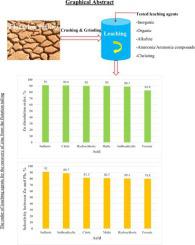Minerals Engineering ( IF 4.8 ) Pub Date : 2021-05-06 , DOI: 10.1016/j.mineng.2021.106935 Shokrullah Hussaini , Sait Kursunoglu , Soner Top , Zela Tanlega Ichlas , Muammer Kaya

|
The recovery of zinc from a flotation tailing using 17-different leaching agents, including inorganic and organic acids, alkaline solutions and chelating agents, was investigated. The effects of the lixiviant type, acid concentration, leaching temperature, leaching time, and solid-to-liquid ratio on the metals dissolution were studied. The use of sulfuric acid resulted in 91% of zinc extraction with a high selectivity against lead. The major impurities of lead, iron, calcium and arsenic precipitated during the leaching process as a segnisite, beudantite, gypsum, and goethite in this lixiviant. It was seen that the addition of oxidants in sulfuric acid solution slightly increased zinc dissolution. The citric acid dissolved 90.1% of zinc along with 9.1% lead. 90% of zinc dissolution was achieved by using malic acid, and high selectivity between zinc and lead dissolutions was also observed. The citric and malic acid leach residues contained a substantial amount of segnitite, beudantite, and quartz as the major phases. In term of zinc and lead dissolution selectivity, the best inorganic agents were determined in the following order: sulfuric acid > hydrochloric acid > perchloric acid > nitric acid. With organic agents, the best zinc and lead selectivity was achieved in the following order: sulfosalicylic acid > citric acid > malic acid > formic acid > tartaric acid > ascorbic acid. The best simultaneous zinc and lead dissolutions were achieved using sodium hydroxide agent. Using 5 M sodium hydroxide at 80 °C and 1/10 solid-to-liquid ratio for 180 min. leaching time, 81.4% of zinc and 47.4% of lead were dissolved while leaving a considerable amount of iron in the residue. When the ammonium chloride was used as a lixiviant, the silver and zinc were taken into the leach solution. 61.3% of zinc dissolution was obtained by using 50% ammonia as lixiviant, whereas no iron and lead dissolutions were observed. Using 0.37 M EDTA at 80 °C, 1/10 solid-to-liquid ratio for 180 min. leaching time, more than 90% of zinc dissolved along with a substantial amount of iron, arsenic and lead co-dissolutions. 47.4% of zinc dissolution was obtained at 80 °C and 1/10 solid-to-liquid ratio for 180 min. leaching time when sodium citrate was used as lixiviant, whereas less than 20% of zinc dissolved using ammonium oxalate at similar leaching condition. 39% zinc was dissolved using 3 M ammonium acetate at 80 °C, 1/10 solid-to-liquid ratio for 180 min., while 23.1% of zinc dissolution was achieved when the ammonium acetate was tested under similar experimental conditions. As a result, sulfuric, citric, malic, sulfosalicylic and formic acids were deemed to be the most promising leaching agents for the selective recovery of zinc from the lead–zinc flotation tailing.
中文翻译:

测试从碳酸盐型铅锌矿浮选尾矿中回收锌的17种浸出剂
研究了使用17种不同的浸出剂(包括无机酸和有机酸,碱性溶液和螯合剂)从浮选尾矿中回收锌的方法。研究了浸滤剂类型,酸浓度,浸出温度,浸出时间和固液比对金属溶解的影响。硫酸的使用导致91%的锌提取物具有对铅的高选择性。在浸滤过程中,铅,铁,钙和砷的主要杂质以闪锌矿,球铁矿,石膏和针铁矿的形式沉淀出来。可以看出,在硫酸溶液中添加氧化剂会稍微增加锌的溶解度。柠檬酸溶解了90.1%的锌和9.1%的铅。通过使用苹果酸可实现90%的锌溶解,并且还观察到锌和铅溶解之间的高选择性。柠檬酸和苹果酸浸出残余物中含有大量的半闪石,贝得石和石英作为主要相。就锌和铅的溶解选择性而言,按以下顺序确定了最佳的无机试剂:硫酸>盐酸>高氯酸>硝酸。使用有机试剂,可以按以下顺序获得最佳的锌和铅选择性:磺基水杨酸>柠檬酸>苹果酸>甲酸>酒石酸>抗坏血酸。使用氢氧化钠试剂可以同时实现最佳的锌和铅溶解。在80°C和1/10固液比下使用5 M氢氧化钠处理180分钟。浸出时间为锌的81.4%和47。溶解了4%的铅,同时在残留物中留下了大量的铁。当氯化铵用作浸滤剂时,将银和锌放入浸出溶液中。通过使用50%的氨作为浸滤剂,锌溶解度达到61.3%,而没有观察到铁和铅的溶解度。在80°C下使用0.37 M EDTA,固液比1/10,持续180分钟。浸出时间超过90%的锌与大量铁,砷和铅的共溶解一起溶解。在80°C和1/10的固液比下持续180分钟,锌溶解度为47.4%。当使用柠檬酸钠作为浸滤剂时的浸出时间,而在相似的浸出条件下,使用草酸铵溶解的锌少于20%。使用3 M醋酸铵在80°C,1/10固液比下溶解39%的锌180分钟。在相似的实验条件下测试乙酸铵时,锌的溶出度达到23.1%。结果,硫酸,柠檬酸,苹果酸,磺基水杨酸和甲酸被认为是从铅锌浮选尾矿中选择性回收锌的最有希望的浸出剂。


























 京公网安备 11010802027423号
京公网安备 11010802027423号